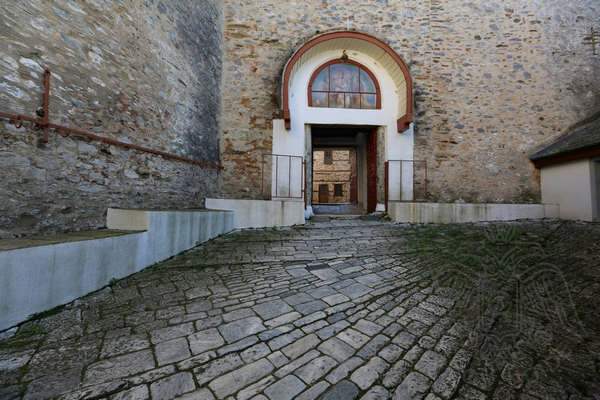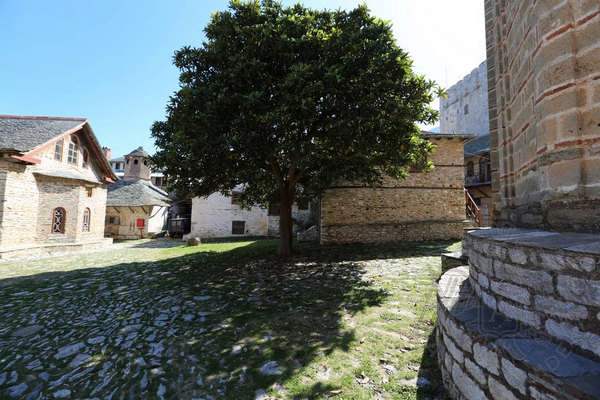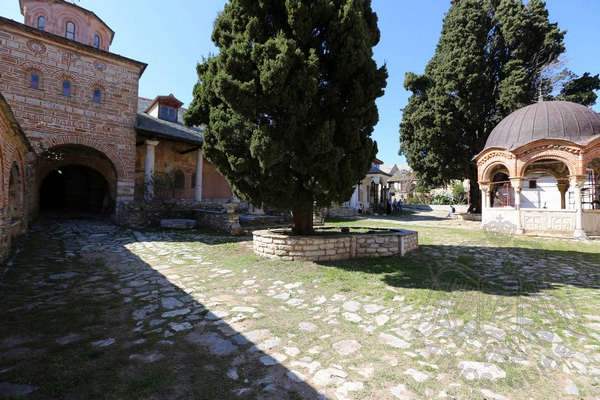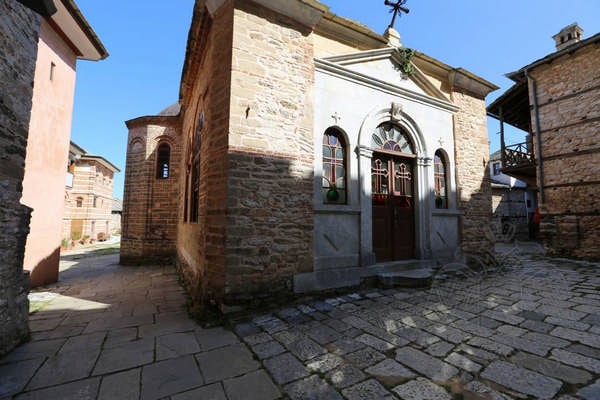History and present days
The First Monastery
 Walking along the coastal road towards the Monastery of Great Lavra, a path on the right leads to the sanctuary of Saint Athanasius. According to tradition, while constructing the monastery, Saint Athanasius faced a shortage of water and food. He set out for Karyes to send a message to the Emperor Nikephoros Phokas, requesting assistance. At the location of the sanctuary, approximately a two-hour walk from the monastery, Theotokos appeared before him. To prove that her presence was not a temptation, she instructed him to strike a rock with a cross-shaped motion in the name of the Holy Trinity. Immediately, a spring of water began to flow, maintaining a steady supply throughout the year. Theotokos commanded the construction of a church on the site, ensuring holy services would regularly take place there, while she also promised to care for the monastery until the end of time. The current form of the church, dedicated to the Life-Giving Spring, is result of a renovation of 1892.
Walking along the coastal road towards the Monastery of Great Lavra, a path on the right leads to the sanctuary of Saint Athanasius. According to tradition, while constructing the monastery, Saint Athanasius faced a shortage of water and food. He set out for Karyes to send a message to the Emperor Nikephoros Phokas, requesting assistance. At the location of the sanctuary, approximately a two-hour walk from the monastery, Theotokos appeared before him. To prove that her presence was not a temptation, she instructed him to strike a rock with a cross-shaped motion in the name of the Holy Trinity. Immediately, a spring of water began to flow, maintaining a steady supply throughout the year. Theotokos commanded the construction of a church on the site, ensuring holy services would regularly take place there, while she also promised to care for the monastery until the end of time. The current form of the church, dedicated to the Life-Giving Spring, is result of a renovation of 1892.
History
The foundation of the Monastery of Megisti (Great) Lavra in 963 by Saint Athanasius the Athonite marks the beginning of cenobitic monasticism in Mount Athos. The monastery was built in the region of Melana, where the saint had previously lived as a hermit. There he constructed a church dedicated to the Dormition of the Virgin Mary.
The monastery has been known by various names, including "Lavra of Melana," "Lavra of Saint Athanasius," "Megali (Big) Lavra," "Lavra," etc. The title "Lavra" was retained even after the transition into a cenobitic monastery.
According to his biography, Saint Athanasius first constructed the outer fortification walls, followed by the katholikon and the monks' cells. He had to face numerous hardships, in which he was supported by his prayers and the generous patronage of the Emperor Nikephoros II Phokas. The emperor endowed the monastery with metochia, including the Monastery of Peristeres near Thessaloniki, a part of the Holy Cross, sacred relics and other valuable treasures. He also secured the first monastic community of 80 monks by granting an annual fund of 244 gold coins. This support enabled Saint Athanasius to realize his vision of establishing a cenobitic monastery, an endeavor that earlier ascetics, such as Saint Euthymius the Younger, had attempted unsuccessfully.
Following the assassination of Nikephoros Phokas in 969 by the General John Tzimiskes, the latter ascended to the throne. Despite this shift in power, Tzimiskes doubled the imperial grant to the monastery, allowing for the completion of its construction. Despite the controversy, he is venerated as a co-benefactor of the monastery alongside Nikephoros Phokas.

As the number of monks grew, cenobitic monasticism was established in Mount Athos. The Emperor Basil II, known as the "Bulgar-Slayer," donated numerous metochia to the community, including the island of Saint Efstratios.
Beyond the spiritual and structural development of the monastery, Saint Athanasius also offered a solution for all practical needs. He constructed a watermill, planted vineyards and established a home for monks in Milopotamos. He used to oversee all projects, while he also remained dedicated to his monastic vision.
Athanasius was succeeded by Anthony, following the saint’s own recommendation. Like Athanasius, Anthony also enjoyed the favor of the emperors, whose donations continued during the tenure of his successors, Theodorite, Eustratios and Michael. The Second Typikon of Mount Athos (1045) reaffirmed Lavra’s privileged status, placing it at the top of the monastic hierarchy.
In 1057, the chrysobull of Michael VI increased the monastery’s financial support from the 488 gold coins granted by the Emperor John Tzimiskes to 812 coins. Subsequent emperors, including Constantine Doukas, Alexios I Komnenos and the Palaiologans, beginning with Michael VIII, have been similarly generous.
The monastery’s land holdings expanded until the 15th century through the annexation of both abandoned and active monastic institutions. This territorial growth was accompanied by an increase in the number of monks. By the late 10th century, Great Lavra housed 160 monks, a number that had risen to approximately 700 by the mid-14th century. The period between the 11th and 14th centuries was marked by great prosperity, attracting numerous renowned ascetics, among whom there was Saint Gregory Palamas.
This era of flourishing was followed by a period of decline. The pirate raids of the 14th century and the Ottoman occupation from the 15th century onward led to a significant depopulation of the monastery. The strict application of Saint Athanasius’ monastic rules started to fade and the number of monks decreased. By the early 16th century, Great Lavra had too few monks to sustain its cenobitic way of organization. As a result, the monastery was transformed into an idiorrhythmic community, a development that failed to reverse the ongoing decline.
By the early 16th century, when Neagoe Basarab, the Voivode of Wallachia (1512–1521), assumed patronage of the monastery, the number of monks remained low. However, thanks to the efforts of Patriarch Sylvester of Alexandria and the Holy Synaxis, the monastery was restored to the cenobitic system in 1575 by a decree of the Patriarch Jeremias II. Extensive restoration and renovation work were undertaken during this period. The monastery’s relative financial stability enabled it to assume responsibility for paying the taxes of other monasteries. However, the burden of these heavy taxes proved unsustainable, leading once again to decline. By 1623, when Patriarch Anthimos II visited the monastery, he found only five or six monks living in poverty.
In 1662, Patriarch Dionysius III Bardalios devoted his entire personal fortune to the reconstruction of the Monastery of Great Lavra. Nevertheless, it once again reverted to the idiorrhythmic system.
The 18th century was a period of prosperity, driven by economic and literary growth in the Greek communities of the Danubian Principalities, the West and the Aegean islands. In 1759, the monastery became home to the first Greek printing press. However, the latter was soon destroyed by the Ottomans.
During the Greek War of Independence in 1821, 117 monks resided at the monastery, with an additional 448 monks used to live in its dependencies. Some joined the revolutionary forces under Emmanuel Pappas. The subsequent decade of Ottoman raids in Mount Athos (1821–1830) brought great suffering to the monastery, as it did to the entire Athonite community.
In 1963, the millennial anniversary of the monastery’s founding was celebrated with great solemnity in the presence of the Ecumenical Patriarch, other patriarchs and King Paul of Greece. At the time, the monastery remained idiorrhythmic and faced significant depopulation.
In 1980, the Monastery of Great Lavra returned to the cenobitic system. On the feast day of Saint Athanasius, the monastery enthroned its first abbot in modern history.










